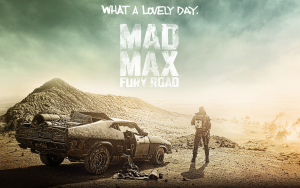
It’s been over three decades since George Miller’s original release of “Mad Max” in 1979. A film series that is arguably responsible for launching both Mel Gibson’s career and Austrian New Wave movies internationally.
Now 30 years since “Beyond Thunderdome,” Miller released the highly-anticipated “Mad Max: Fury Road,” 16 years after its inception.
“Fury Road” brings us back to Miller’s brilliantly envisioned post-apocalyptic world, where former cop/all-around-drifter Max Rockatansky, now played by Tom Hardy, is pedal-to-the-medal trying to escape the band of marauders in hot pursuit.
Max is eventually caught by followers of Immortan Joe (Hugh Keays-Byrne), a warlord, who is as ruthless as he is hideous. Joe controls the water supply of The Citadel and therefore the people.
Max runs into Imperator Furiosa (Charlize Theron), one of Joe’s lieutenants and driver of the massive war rig. Furiosa, rather than make a scheduled trip to Gastown, makes off with five wives of Joe’s Harem for The Green Place, a promised land where she grew up.
What ensues can only be described as a brilliantly strange, grotesquely violent and beautiful chase scene that never really stops.
The acting was fantastic. Theron gives a stellar performance and, for at least the first half of the film, the movie could have been seemingly title “Imperator Furiosa.” Hardy’s Max is not better than Mel Gibson’s. However, this is largely due to writing.
Max is nearly mute for the majority of the film. Gibson’s Max seemed much more personal, had elements of humor and elements such as the inclusion of a dog made him more relatable.
Hardy’s Max is certainly more mad. He experiences frequent flashbacks and PTSD symptoms and his reservations are also likely a by-product of this.
Cinematography and CGI are consistently amazing. Every frame of the film is iconic and seems as though it could have been used for the movie poster. Action, while completely absurd, is well choreographed and easy to follow.
It should also be noted that every car stunt is real, although some of their ornamentations may not be.
“Fury Road” is likely to become many’s favorite installment in the franchise (second perhaps only to the very similar “Road Warrior”). The “Mad Max” franchise presents a bleak image of human nature, scarcity and moral decay, that now over three decades later it still embodies.
Miller, in a recent interview with Crave Online, said, “I mean, [“Mad Max] was triggered by the oil crisis in 1972. I remember it really stuck in my mind, in a very peaceful city like Melbourne, our southern capital, or some city, it took ten days after a severe oil shortage for the first shot to be fired.”